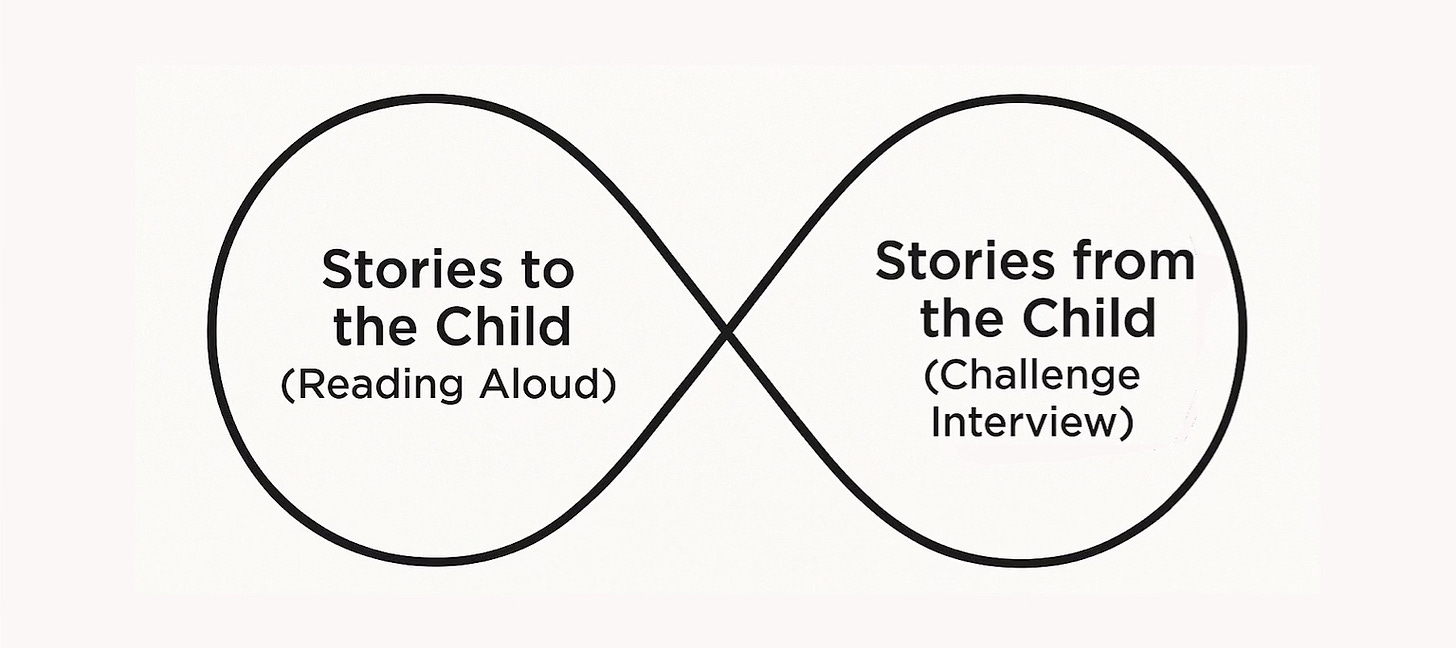The Dual Arc of Identity
Why Daily Reflection Must Follow Daily Reading?
We’ve all heard the advice: Read aloud to your child daily. And for good reason.
Reading aloud isn’t just about literacy. It’s how children begin to understand themselves. Story teaches rhythm, emotion, and sequence. It offers structure for experience. Reading together becomes a rehearsal for making sense of the world.
The warmth of their head on your arm. The slow page turn. The way their breathing matched the cadence of your voice. These weren’t just bedtime rituals. They were the first scaffolding of identity.
But when shared narration ends—often right as a child begins to think abstractly—we unintentionally remove the structure they need to process their world.
When independent reading begins, many parents stop reflecting with their children around age eight. We teach them to decode text but not to narrate themselves. Without that daily habit, identity formation drifts, and meaning slips away.
Without narrative, children don’t lose intelligence—they lose direction.
In a culture that promotes early independence but doesn’t teach inner narration, we’ve left children fluent in reading but inarticulate in reflection.
This first arc of identity is a story flowing inward. The parent narrates, and the child receives. In that repetition, rhythm becomes memory, and memory becomes structure—a foundation for coherence. Identity takes shape through presence, not performance.
Then the shift begins.
Children start reading alone. They crave autonomy. Bedtime stories taper off. Schedules tighten. Screens slip in. And without ceremony, the parent’s voice fades into the background.
We often call this growth. “They’re reading chapter books now!”
But what looks like maturity is often the first wave of emotional distancing—one we confuse with readiness when it’s actually when they need us most.
Beneath the celebration, something critical slips away: the shared narration, the check-in, the quiet, daily act of co-creating meaning. The child may still read, but the reflection is gone.
And silence doesn’t last.
In the absence of parental rhythm, the algorithm rushes in. TikTok, YouTube Shorts, and Instagram Reels—platforms built for dopamine, not development—begin to shape the child’s attention. The scroll is endless. Feedback is instant. The story dissolves.
Their voice fades. The scroll takes over.
We’ve handed the mic to machines that don’t love them, don’t listen, and don’t care how the story ends.
Reflection isn’t optional anymore—it’s a survival skill.
There’s no beginning, middle, or end. Just loops. Just mimicry. Just noise. The child still forms identity, but increasingly by reaction, not reflection. They string fragments—a joke, a filter, a borrowed tone—and try to build a self from them.
They’re building a self, but from other people’s stories.
What if I miss the moment they stop letting me in—and don’t realize it happened?
This is the breach.
It doesn’t explode. It seeps. Experiences go unspoken. Emotions unnamed. The day blurs. When nothing is turned into a story, nothing sticks. The child drifts—not from lack of depth, but from lack of rhythm.
This is when the second arc must begin.
If the first arc is story flowing in, the second is story flowing out—not through essays or journaling, but through daily reflection. This is where ritual returns—not for nostalgia, but for repair. The Challenge Interview is that ritual.
It’s a 20-minute, post-activity conversation. Not a review. Not a check-in. A protected rhythm. It happens in the in-betweens—after school, after practice—while the day lingers and emotions are still raw.
The questions are simple but calibrated. “What part of today felt like a walk? A gallop?” “What was harder than expected?” “What changed between beginning and end?” These aren’t interrogations. They’re invitations. Small story-shaping tools.
Between 8 and 12, children shift from concrete to abstract thought. They notice what’s unsaid. They sense unfairness. They feel nuance but don’t have language for it. Reflection doesn’t just help them speak—it helps them see.
“I don’t know what she’s feeling anymore,” one father told me. “I just get eye rolls now.”
One night, after a Challenge Interview, a girl told me, “I thought Maya was ignoring me, and I got mad. But I think maybe she was just nervous too.” That’s it. The narrator waking up—not with answers, but awareness.
And here’s what often surprises parents: it works both ways. When you hold space for their reflection, your story returns to focus. You see where you checked out. Where did you show up? Where did you miss something? Parenting becomes less about correction and more about co-authorship.
In a fractured world, helping children narrate their story may be one of the last ways we remember how to narrate our own.
The Challenge Interview doesn’t require perfection—just presence. For parents who feel that connection doesn’t come naturally or who are rebuilding it, it’s a gentle, repeatable way back in.
So here’s the invitation.
If you once read aloud at night, shaped your child’s world with story and voice, know that the work isn’t done. That was just the first arc. The second asks for something different. Not performance. Not protection. But partnership.
Begin the Challenge Interview not as a fix, but as a return. One question. One moment. Find the chatterbox window—that soft time after school or practice when their guard is down. Enter it quietly. Stay curious. Let the story emerge.
Even if the stories stopped long ago—even if you feel you’ve missed the window—it’s not too late.
Reflection only grows more necessary with time.
In helping them find coherence, we remember our own. The thread runs both ways.
Because we are not just raising children.
We are raising narrators.
In a world flooded with noise, the child who can say, “This is what I felt. This is what I learned. This is who I’m becoming,” won’t survive the chaos.
They’ll shape it.



